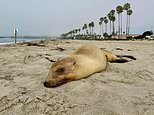
By Rachel Bowman For Dailymail.Com and Associated Press
Published: | Updated:
A surge of sick sea lions are washing up along the California coast suffering from symptoms of algae poisoning, experts say.
The Marine Mammal Center in Sausalito has responded to 90 sick sea lions in San Luis Obispo County since July 29, and nearly 30 percent of the animals they helped have died.
Experts found the sea lions are suffering from domoic acid poisoning, a neurotoxin that affects the brain and heart, according to the National Oceanic and Atmospheric Administration (NOAA).
Strong upwelling of nutrient-laden water from the deep ocean is driving a bloom of the harmful algae.
‘Unfortunately, many animals are dying on the beach before we have a chance to rescue them. This indicates a high level of exposure to domoic acid,’ said Ruth Dover, Managing Director of the Channel Islands Marine & Wildlife Institute.
A surge of sick sea lions are washing up along the California coast suffering from symptoms of algae poisoning
Experts found the sea lions are suffering from domoic acid poisoning, a neurotoxin that affects the brain and heart
The Channel Islands group said they are getting nearly 100 calls a day about sick marine mammals and has rescued 45 sea lions in the first 10 days of the outbreak.
‘The good news is that people realize something is wrong and know who to call,’ said Dover. ‘The bad news is that many of these animals are really suffering.’
‘This is especially concerning because these blooms didn’t use to be an annual event.’
The strong upwelling that causes the algae bloom is a common spring-to-summer occurrence, driven by winds that help draw cold water up from the deep ocean along the coast.
Hundreds sea lions and dozens of dolphins died along the Southern California coast from domoic acid last year.
This years short-lived local marine heatwave first warmed coastal waters may have set up the algae for rapid growth, according to NOAA researchers.
Domoic acid, a neurotoxin produced by the algae Pseudo-nitzschia, enters the food chain and sickens marine mammals as they eat prey.
Satellite maps off the California coast show the upwelling of colder than usual waters that provide ideal growing conditions for the toxin-producing algae
Teams rescue affected sea lions and admit them to a rehabilitation facility, but for many their condition may be too advanced to help
‘The upwelling helps make the California Coast such a rich ecosystem, but in this case there is another effect that we see playing out with marine mammals,’ said Clarissa Anderson, Executive Director of the Southern California Coastal Ocean Observing Network.
Satellite maps off the California coast show the upwelling of colder than usual waters that provide ideal growing conditions for the toxin-producing algae.
‘The levels we’re finding inside these animals is off the charts,’ Giancarlo Rulli, a spokesman for the Sausalito-based Marine Mammal Center told the Los Angeles Times. ‘It’s all hands on deck.’
Teams rescue affected sea lions and admit them to a rehabilitation facility, but for many their condition may be too advanced to respond to treatment and have to be put down.
NOAA recommends beachgoers and their pets should stay a safe distance from affected animals on shore and report them.






